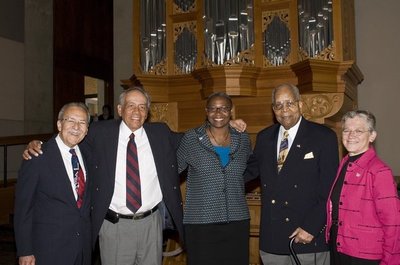May 22, 2008
Vice presidents reminisce, look ahead
After 40 years of work on behalf of diversity at the UW, many of the challenges which prompted the initial protests still remain, but the agenda has broadened in ways that no one back in 1968 could have predicted.
A unique panel of five current and former vice presidents in what is now the Office of Minority Affairs and Diversity exchanged views and reminiscences at a discussion that was held as part of the 40th anniversary celebration of diversity efforts.
Samuel Kelly, the very first vice president (from 1970 to 1976) — and first person to hold the title of vice president for minority affairs at a major university — recalled a time when the UW had acquired a reputation as being insensitive to minority issues. He credited then-president Charles Odegaard with leading a dramatic change in the environment: “He never lied to me, and he stuck with me. Had it not been for him, none of us would be up here on this panel today.” He said that what ended up being created at the UW over the following years was “the likes of which will not be created in higher education in my lifetime.”
Herman Lujan, who followed Kelly as vice president from 1978 to 1988, stepped into a situation where concerns about access to the UW were supplanted by concerns about success. “We needed to develop and build academic performance, and move beyond rebellion,” he said. “When I started, the graduation rate of minority students was about 17 percent, but by 1988 it was 52 percent — due in large part to the work of the staff in the Office of Minority Affairs.”
Myron Apilado became vice president in 1990, and during his tenure the state passed Initiative 200, which prohibited the use of race as a factor in admissions. He recalls those years as tough and frustrating, as the University was forced to implement “that ill-conceived initiative. We had a sense that it was the beginning of the end of the reason to have an Office of Minority Affairs. We could no longer admit students through the Educational Opportunity Program. It was a shame, because in my view before I-200 we never admitted a single student who was not up to the academic challenges of the UW.”
For Rusty Barcelo, vice president from 2001 to 2006, I-200 was history, and in some ways a helpful spur to a rethinking of the concept of diversity. “We were forced to have a different conversation, within the parameters of the law,” she said. “We had to rethink our relationship with the community, where the UW was not well understood, and we adopted a more holistic approach to admissions. So, by 2006, we were able to accept one of the most diverse classes ever. We learned to think beyond admissions, to think about faculty and curriculum, so that diversity was aligned to the institution’s academic mission.”
Sheila Edwards Lange, the current vice president, characterized her challenge as continuing the legacy of those who have come before her. “OMA made it possible for me to go to college and stay in college,” she said. “Now we have many offices outside of minority affairs that need and want to be engaged in promoting diversity, but they don’t know how. We have become a resource for those units, many of which are still discussing the issues of access that we first broached 40 years ago. And we are creating partnerships with community organizations. Coordination, right now, is our greatest challenge.”
Barcelo pointed out that issues of diversity need to move from the periphery to the core of universities. “We need to become institutionalized, but not to lose our critical edge. We are in a time of positive transformation within higher education. The growth of child care, tutoring programs and scholarships all come from a greater diversity on campus.”
Lange said the thing that she finds most encouraging is the next generation coming up through the University. “This crop of students is unbelievable,” she said. “They believe they can change the world, that they can make a real difference. And they are doing that. They are translating their sense of optimism into real projects that are making a difference in the community.”

